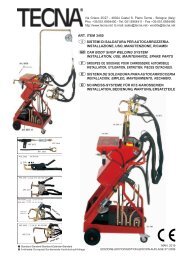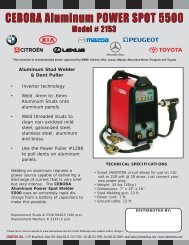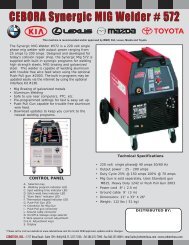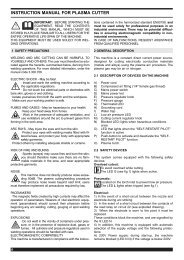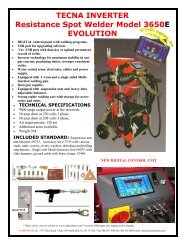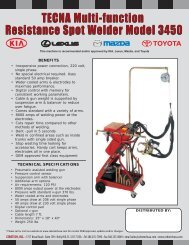instruction manual for capacitor discharge ... - Cebotechusa.com
instruction manual for capacitor discharge ... - Cebotechusa.com
instruction manual for capacitor discharge ... - Cebotechusa.com
Create successful ePaper yourself
Turn your PDF publications into a flip-book with our unique Google optimized e-Paper software.
INSTRUCTION MANUAL FOR CAPACITOR DISCHARGE WELDING MACHINE<br />
IMPORTANT: BEFORE STARTING THE EQUIPMENT,<br />
READ THE CONTENTS OF THIS MANUAL, WHICH MUST<br />
BE STORED IN A PLACE FAMILIAR TO ALL USERS FOR<br />
THE ENTIRE OPERATIVE LIFE-SPAN OF THE MACHINE.<br />
THIS EQUIPMENT MUST BE USED SOLELY FOR WELD-<br />
ING OPERATIONS.<br />
1 SAFETY PRECAUTIONS<br />
WELDING AND ARC CUTTING CAN BE HARMFUL TO<br />
YOURSELF AND OTHERS. The user must there<strong>for</strong>e be educated<br />
against the hazards, summarized below, deriving from<br />
welding operations. For more detailed in<strong>for</strong>mation, order the<br />
<strong>manual</strong> code 3.300.758<br />
ELECTRIC SHOCK - May be fatal.<br />
· Install and earth the welding machine according to<br />
the applicable regulations.<br />
· Do not touch live electrical parts or electrodes with<br />
bare skin, gloves or wet clothing.<br />
· Isolate yourselves from both the earth and the workpiece.<br />
· Make sure your working position is safe.<br />
FUMES AND GASES - May be hazardous to your health.<br />
· Keep your head away from fumes.<br />
· Work in the presence of adequate ventilation, and<br />
use ventilators around the arc to prevent gases from<br />
<strong>for</strong>ming in the work area.<br />
ARC RAYS - May injure the eyes and burn the skin.<br />
· Protect your eyes with welding masks fitted with filtered<br />
lenses, and protect your body with appropriate<br />
safety garments.<br />
· Protect others by installing adequate shields or curtains.<br />
RISK OF FIRE AND BURNS<br />
· Sparks (sprays) may cause fires and burn the skin;<br />
you should there<strong>for</strong>e make sure there are no flammable<br />
materials in the area, and wear appropriate<br />
protective garments.<br />
NOISE<br />
This machine does not directly produce noise<br />
exceeding 80dB. The plasma cutting/welding procedure<br />
may produce noise levels beyond said limit;<br />
users must there<strong>for</strong>e implement all precautions required by<br />
law.<br />
PACEMAKERS<br />
· The magnetic fields created by high currents may<br />
affect the operation of pacemakers. Wearers of vital<br />
electronic equipment (pacemakers) should consult<br />
their physician be<strong>for</strong>e beginning any arc welding, cutting,<br />
gouging or spot welding operations.<br />
EXPLOSIONS<br />
· Do not weld in the vicinity of containers under pressure,<br />
or in the presence of explosive dust, gases or<br />
fumes. · All cylinders and pressure regulators used in<br />
welding operations should be handled with care.<br />
ELECTROMAGNETIC COMPATIBILITY<br />
This machine is manufactured in <strong>com</strong>pliance with the<br />
<strong>instruction</strong>s contained in the harmonized standard<br />
EN50199, and must be used solely <strong>for</strong> professional purposes<br />
in an industrial environment. There may be potential difficulties<br />
in ensuring electromagnetic <strong>com</strong>patibility in nonindustrial<br />
environments.<br />
IN CASE OF MALFUNCTIONS, REQUEST ASSISTANCE<br />
FROM QUALIFIED PERSONNEL.<br />
2 GENERAL DESCRIPTIONS<br />
2.1 SPECIFICATIONS<br />
The machine has been designed and built <strong>for</strong> welding ferrous<br />
and non-ferrous threaded stud bolts, Ø 4. 5 and 6 mm.<br />
This welding system uses the extremely rapid (2-3 ms) <strong>discharge</strong><br />
of a battery of <strong>capacitor</strong>s, which allows the welding<br />
of threaded stud bolts with contact point start-up.<br />
2.2 EXPLANATION OF THE TECHNICAL SPECIFICA-<br />
TIONS LISTED ON THE MACHINE PLATE<br />
N° Serial number, which must be indicated on any<br />
request regarding the welding machine<br />
IEC 60974-1 The welding machine is manufactured according<br />
EN 50199 to these international standards.<br />
1 ~<br />
Single-phase trans<strong>for</strong>mer-rectifier with<br />
device <strong>for</strong> charging and discharging the<br />
<strong>capacitor</strong>s<br />
U0 Secondary open-circuit voltage<br />
E Welding energy<br />
C Capacity value<br />
Uc Voltage adjustable on the <strong>capacitor</strong>s<br />
U1 Rated supply voltage. The machine is set up <strong>for</strong><br />
voltages of 115V and 230V with automatic<br />
voltage change.<br />
1-50/60Hz 50- or 60-Hz single-phase power supply<br />
I1 Max Max. absorbed current at the corresponding<br />
supply voltage.<br />
IP23C Protection rating <strong>for</strong> the housing. Grade 3 as the<br />
second digit means that the equipment is<br />
suit able <strong>for</strong> use outdoors in the rain.<br />
C: The additional letter C means that the<br />
equipment is protected against access to the<br />
live parts of the power circuit by a tool (diameter<br />
2.5 mm ).<br />
S Suitable <strong>for</strong> use in high-risk environments.<br />
NOTES: Suitable <strong>for</strong> use in environments with a pollution<br />
rating of 3 (see IEC 60664-1)<br />
2.3 DESCRIPTION OF PROTECTIVE DEVICES<br />
2.3.1 Thermal protection<br />
This machine is protected by a thermostat, which prevents<br />
the machine from operating if the allowable temperatures are<br />
exceeded. Under these conditions the fan keeps running<br />
and the display will show error code E1.<br />
7
3 INSTALLATION<br />
Only skilled personnel should install the machine. All connections<br />
must be carried out according to current regulations,<br />
and in full observance of safety laws (regulation CEI<br />
26-10 - CENELEC HD 427).<br />
1. Place the welding machine in a stable and safe position.<br />
Air must circulate freely, both in<strong>com</strong>ing and outgoing,<br />
and the welding machine must be protected from entry<br />
by liquids, dirt, metal filings, etc.<br />
2. Make sure that the supply voltage matches the voltage<br />
indicated on the specifications plate of the welding<br />
machine. When mounting a plug, make sure it has an<br />
adequate capacity, and that the yellow/green conductor<br />
of the power supply cable is connected to the earth pin.<br />
The capacity of the overload cutout switch or fuses<br />
installed in series with the power supply must be equivalent<br />
to the absorbed current I1 of the machine.<br />
Any extension cords must be sized appropriately <strong>for</strong> the<br />
absorbed current I1.<br />
If the power supply is 115V, the machine may run <strong>for</strong><br />
voltages between 96V and 140V.<br />
If the power supply is 230V, the machine may run <strong>for</strong><br />
voltages between 190V and 260V.<br />
The machine must be switched off when changing the<br />
power supply.<br />
3. Pacemaker wearers are prohibited from using the<br />
8<br />
A<br />
B<br />
F G<br />
J<br />
E<br />
D<br />
C<br />
H<br />
Fig. 1<br />
machine or approach the cables.<br />
4. Fully insert the earth cable plug into the + socket and<br />
turn clockwise.<br />
5. Fully insert the gun plug into the - socket and turn clockwise.<br />
6. Turn on the welding machine using the I switch. (start-up<br />
and shutdown should not be repeated frequently,<br />
because dissipating the energy contained in the <strong>capacitor</strong>s<br />
may cause overheating and damage).<br />
7. To limit exposure to the magnetic field, keep the gun<br />
cable on the side of the hand holding it, avoiding wrapping<br />
the cable around.<br />
3.1 DESCRIPTION OF THE EQUIPMENT<br />
A- Key to increase the <strong>capacitor</strong> charge voltage<br />
B- Key to reduce the <strong>capacitor</strong> charge voltage<br />
C- LED indicating that the machine is on<br />
D- LED that lights during welding<br />
E- Displaying showing the <strong>capacitor</strong> charge voltage<br />
F- Positive output terminal<br />
G- Negative output terminal<br />
H- Torch trigger connector<br />
I- Main switch<br />
J- Fuse Ø 6.3x32 (delayed type). The equipment is fitted<br />
with a 16A fuse <strong>for</strong> 115V power supply; a 10A fuse may<br />
be used <strong>for</strong> 230V power supply.<br />
I
3.2 GUN DESCRIPTION<br />
X<br />
S Z T R U O K P Q<br />
X W V M N L<br />
Fig. 2<br />
K- Gun body<br />
L- Grip<br />
M- Control cable<br />
N- Welding current cable<br />
O-Welding <strong>com</strong>mand button (works only with the gun<br />
pressed against the sheet metal)<br />
P- Force setting indicator<br />
Q- Force adjustment screw (increases when turned clock<br />
wise)<br />
R- Ring to hold spacer Z<br />
S- Clamp locking ring-nut<br />
T- Safety bellows<br />
U- Holding screws <strong>for</strong> ring R<br />
V- Screw to adjust stud bolt protrusion<br />
W- Holding nut.<br />
X- Stud bolt gripping clamp<br />
Y- Screw<br />
Z- Spacer<br />
3.2.1 Preparing the gun<br />
Always use high-quality pins with contact point start-up <strong>for</strong><br />
<strong>capacitor</strong> <strong>discharge</strong> welding, which <strong>com</strong>ply with standards<br />
and are made of a metal <strong>com</strong>patible with the welding to be<br />
done.<br />
Having selected the stud bolt to be welded <strong>for</strong> type, diameter,<br />
length and material, use and adjust the clamp according<br />
to the corresponding diameter.<br />
Insert the stud bolt in the clamp X so that it is firmly held in<br />
place by the four springs.<br />
Adjust the protrusion of the stud bolt from the front of the<br />
clamp to 0.8 ÷ 1.2 mm using the screw V, then tighten with the<br />
nut W (figure 2).<br />
Insert the clamp X into the chuck of the gun (fig. 2), press<br />
until you feel it rest all the way down, and tighten the nut S<br />
using the 17-mm hexagon wrench provided.<br />
4 OPERATING PRINCIPLE OF WELDING<br />
THREADED STUD BOLTS WITH CONTACT<br />
POINT START-UP (Fig. 3)<br />
The stud bolt is inserted in the clamp X (phase 1), then positioned<br />
and pressed with its start-up contact directly against<br />
the surface of the sheet metal to be welded (phase 2). The<br />
spring of the gun presses the stud bolt against the metal, the<br />
start <strong>com</strong>mand begins sending current which melts the<br />
start-up contact, and the electrical arc is propagated along<br />
the entire surface of the stud bolt (phase 4) pushed against<br />
the metal surface. The molten metal solidifies, thereby welding<br />
the stud bolt (phase 5).<br />
Fig. 3<br />
9
Base metal<br />
The gun must be extracted in perfect alignment with the bolt<br />
to avoid de<strong>for</strong>ming the clamp, and thus ensuring its long lifespan<br />
(phase 6).<br />
5 WELDABILITY OF TYPICAL STUD BOLT/BASE<br />
METAL COM BINATIONS FOR CAPACITOR<br />
DISCHARGE WELDING. (Table 1)<br />
It is important to pay careful attention to the resistance and<br />
de<strong>for</strong>mity at the welding point between the stud bolt and<br />
base metal. In the case of steel, you must pay particular<br />
attention to brittleness.<br />
The material and resistance of the stud bolt have limited tolerance;<br />
the carbon content in steel threaded stud bolts must<br />
be < 0.20%.<br />
The surface of the base metal must be clean. Layers of paint,<br />
rust, waste, grease and non-weldable metal coatings must<br />
be removed from the welding area. This must be done using<br />
appropriate means. Base metals with layers of waste and<br />
rust must be cleaned thoroughly.<br />
6 WELDING<br />
This technology makes it possible to weld threaded stud<br />
bolts on clean, but not oxidized, surfaces of mild steel, galvanized<br />
steel, stainless steel, aluminum and brass.<br />
The rapidity of the process does not alter the surfaces on the<br />
side opposite from the welding. Welding is not possible on<br />
case-hardened steel, oxidized or painted metal.<br />
Be<strong>for</strong>e beginning production it is essential to carry out a few<br />
test welds to determine the proper setting of the power<br />
source and gun (spring <strong>for</strong>ce), proceeding as follows:<br />
· insert the chosen stud bolt in the clamp X (previously<br />
adjusted as described in Fig. 2)<br />
· arrange the base sheet metal in conditions identical to<br />
those that will be used <strong>for</strong> the job in terms of thickness, earth<br />
connection area, size of the workpiece, material quality.<br />
· the terminals of the earth cable should be placed symmetrically,<br />
and as close as possible to the welding point.<br />
· activate the power source by means of the lighted switch I.<br />
· grip the gun and press it against the sheet metal, making<br />
sure that its axis remains perpendicular to the surface. If the<br />
10<br />
Stud bolt metal<br />
Copper plated Stainless Brass Al. Mg 3 AISi 12 Al. 99,5<br />
steel 0.2 C steel Cu Zn 38<br />
Steel up to 0.30 C % A A A - - A<br />
Galvanized steel B B A - - -<br />
Stainless steel A A B - - -<br />
Brass A B A - - -<br />
Copper B - A - - -<br />
Al 99,5 - - - A B B<br />
Al Mg 1 - - - B A B<br />
Al Mg 3 - Al Mg 5 - - - B A B<br />
Al Mg Si - - - B A B<br />
High weldability: A Low weldability: B Not weldable: -<br />
Tab.1<br />
surface of the material on which the stud bolt is to be welded<br />
is flat, we re<strong>com</strong>mend mounting the three spacers Z after<br />
first unscrewing the screws Y.<br />
· carry out a few welds, adjusting the voltage using the keys<br />
A and B, and the <strong>for</strong>ce of the gun using the setting knob Q,<br />
until the welding is perfect.<br />
The gun should be removed keeping it perfectly aligned with<br />
the bolt, to avoid de<strong>for</strong>ming the clamp (Fig4).<br />
Fig. 4<br />
6.1 WELDING ALUMINUM<br />
To weld M4 threaded stud bolts in aluminum alloy Al Si 12<br />
on sheet aluminum <strong>for</strong> auto body work, adjust the voltage to<br />
105/115V. The gun spring that adjusts the pressure during<br />
welding will be adjusted so that the index P is on 2/2.5.<br />
7 MAINTENANCE<br />
7.1 ROUTINE<br />
Keep all <strong>instruction</strong>s and figures on the welding machine<br />
clear and legible.<br />
The mains cable and welding cables must be insulated and
in perfect condition; be careful with the tips, which flex: near<br />
the connection terminals, earth clamps and gun input.<br />
Keep the welding current connectors to sockets F and G<br />
clean and firmly tightened (see Fig. 1)<br />
The terminals <strong>for</strong> connecting to the base metal must make<br />
good contact to avoid overheating, sparks, uneven current<br />
circulation, damage to the <strong>com</strong>ponents where the pins are<br />
welded, and welding of uneven quality.<br />
Prevent dirt, dust and filings from getting into the welding<br />
machine.<br />
Always make sure the cooling air circulates freely.<br />
Make sure that the fan functions properly.<br />
Make sure that the clamps hold the stud bolts firmly, with all<br />
contact springs.<br />
The clamp chuck must slide freely throughout its length,<br />
without changes due to friction or <strong>for</strong>eign matter.<br />
7.2 SPECIAL<br />
Only qualified personnel should per<strong>for</strong>m maintenance.<br />
Some functional errors are highlighted by the appearance of<br />
an error code on the display E.<br />
Error Malfunction Solution<br />
code<br />
E 1 Thermostat trippedl Wait a few minutes<br />
E 2 SCR short-circuited Contact technical<br />
service<br />
E 2 Connectors not Insert the<br />
inserted correctly connector<br />
E 3 Irregular voltage Contact technical<br />
at the <strong>capacitor</strong> tips lservice<br />
E 4 Irregular Contact technical<br />
<strong>capacitor</strong> charging lservice<br />
E 5 Irregular Contact technical<br />
<strong>capacitor</strong> discharging service<br />
Wait at least 5 minutes after shutting off the switch I be<strong>for</strong>e<br />
opening the welding machine, and unplug the plug from the<br />
power socket.<br />
Use a volt meter to make sure that the <strong>capacitor</strong>s are <strong>discharge</strong>d.<br />
Carefully remove any dust, metal fragments and filings from<br />
the machine using <strong>com</strong>pressed air to avoid damaging or<br />
projecting metal fragments onto the electronic or electrical<br />
parts.<br />
Make sure that all connectors are fully inserted.<br />
Make sure that all welding circuit terminals are firmly tightened.<br />
After making a repair, make sure to rearrange the wiring so<br />
that there is secure insulation between the primary and secondary<br />
sides of the machine. Do not allow wires to <strong>com</strong>e into<br />
contact with moving parts or those that heat up during operation.<br />
Reassemble all of the clamps as they were on the original<br />
machine, to prevent an accidental connection between<br />
the primary and secondary circuits if a conductor should<br />
break or disconnect.<br />
Also remount the screws with geared washers as on the<br />
original equipment.<br />
11



